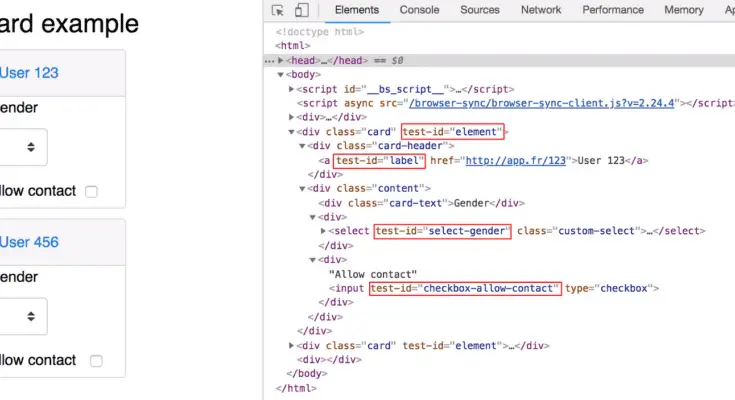During the quick changes in the environment of software development and testing, being able to correctly identify and manipulate web elements quickly becomes a highly demanded skill. Such power is brought by the XPath Tester. A tester or software developer must understand how this tool can be effectively leveraged to improve efficiency and quality of work.
XPath, or XML Path Language, provides navigation of a tree-like structure, for example of an XML or HTML document, and concentrates on the selection of nodes. HTML is a building block of nearly all pages on the Web, using a hierarchical structure in which elements are nested inside of other elements.
XPath provides a way for strongly traversing this structure to select the elements based on criteria. This can include unique identifiers as “id” attributes, position within a document hierarchy or parent-child or sibling relationships, and even the actual text an element contains.
It is in the XPath Tester where you practice your skills in coming up with precise and reliable XPath expressions. With this tool at hand, you can try all kinds of different XPath syntax elements against a live web page or a sample HTML document.
Then, you will know what results your expressions got, and verify that they hit the correct elements. This iterative process refines your expressions to reliably identify the correct elements across a variety of situations.
Other than testing expressions, the XPath Tester can also help to know more about the structure of a webpage. The traversal down the hierarchy of elements and attributes will give you much information on how the page is constructed.
Mastering XPath expressions and putting in action the might of the XPath Tester is supposed to smoothen the testing process in general. You will perform tests more effectively and consistently with test scenarios that direct elements exactly, turning into quickly executed test cases, and hence better software quality releases.
By freeing up valuable time from your testing, you can focus on other critical aspects of the development lifecycle.
Navigating the Complexities of Web Element Identification
The most basic problem or challenge that testers or sometimes even the developers are facing is correctly identifying web elements. In contrast to their highly evolving nature, the internal structure and layout of web pages are typically intricate and dynamic.
It can mean that sometimes, such web elements are loaded chronologically misplaced and hidden by default or even generated after certain user interactions. All these aspects make it tedious, sometimes even impossible, to locate and manipulate particular elements reliably, hence leading to test failures and development bottlenecks.
This is where the XPath testers come into the picture. The tool seeks to provide a user-friendly interface to test and fine-tune your XPath expressions so that you can overcome all obstacles that may be in the way of correct identification of web elements. Be it a simple web page or a complex, multilevel application, the XPath Tester will help you identify the right elements with accuracy.
For writing a test case for a login form, the “username” field could have a unique “id” attribute, which you can easily address via XPath. The “password” field doesn’t have a unique identifier. Then, XPath Tester allows you to try several expressions, for example using the “name” field, or its position in the form structure, and see whether you hit the right element.
This ability to test and refine the expressions in real-time is very important in making your tests reliable and sustainable. For developing an increasingly complex application, it becomes easy to update your XPath expressions in the tester so they will continue to address the elements you want to interact with.
The Pitfalls of Inaccurate Identification
Incorrect identification of elements is a silent pixy, which may be waiting within your automated tests or applications. It happens in so many ways, and each way brings a dose of headaches and time wastage. The following is a detailed explanation of the pitfalls of inaccurate identification,
Test Failures
Consider a login test that acts against an element with a label “Username” when, in fact, there are two elements with that label on that page. In case your test acts on the wrong one, it fails and hence misleads you on functionality.
Application Bugs
This wrong identification may further lead to real-world bugs in your application. Suppose there can be a button that has “Submit” engraved on it; it does nothing if the application’s code doesn’t identify it correctly.
Inconsistent User Experience
If the way elements are identified is inconsistent, then users can get unexpected behavior. Clicking a “Buy Now” button doesn’t always add your product to a shopping cart because of this hardship and dropped sales occur.
Give priority to Precise Element Identification, and you’ll create durable, reliable tests or applications that turn in good results and ensure a smooth user experience.
Precise Element Identification: The Bedrock of Reliable Automation
Accurate element identification lays the basis for stable and reliable automated tests. This way, you can be sure that your tests manipulate the same Web elements on a page whether there are small changes in the layout or updates of dynamic content. This translates to fewer test failures, faster debugging cycles, and ultimately, a high-quality application.
XPath testers, or XPath expressions, offer a powerful and multi-dimensional way to accurately identify elements. This query language will give you the ability to filter elements by unique attributes such as “id,” by their position in the HTML structure, parent-child relationships, or even by text content.
By constructing an effective XPath expression, you will be telling your test script exactly which element it is looking for, even when dealing with complex and dynamic Web pages.
Mastery of the elements precisely through the help of XPath testers puts you in a position to create automation scripts that are not only reliable in their execution but also maintainable.
It could be that minor tweaking in your XPath expressions might be able to keep up, ensuring that your tests stay running smoothly as your application evolves. This will save you time and resources in the long term.
The Importance of Precise Element Identification in Cloud-Based Testing
Testing platforms based on the cloud, like LambdaTest, are game-changing when it comes to running tests across a variety of devices and browsers. However, to unlock the full throttle of these platforms, testers need a reliable and accurate way to identify web elements.
Inconsistent identification of elements might turn out to be the reason for test failure across different environments, which would throttle the speed of the entire development process.
By integrating XPath expressions within your cloud testing workflow you can ensure that your tests hit the right elements every time on any device or browser. This will bring along several different advantages, including,
Improved Test Reliability
Precise identification of elements reduces the possibility of tests interacting with unintended elements, ending up with more reliable and trustworthy test results.
Reliable User Experience
By addressing the right elements in different environments, you will be able to have your application perform as expected and provide a consistent user experience for all users.
Faster Debugging
If the tests are failing because of incorrect element identification, your debugging time is increased. Accurate locators identify the root cause of the error very quickly, thus resolving it faster.
The correct identification of elements is the core of reliable and fast cloud testing. Using XPath testers, it will be easy to carry on the process of testing, detect probable issues at the very initial stage, and thus ensure that quality applications will be delivered fast.
Unleashing the Power of XPath Tester
The XPath Tester is very flexible and is far more than an expression evaluator. You can integrate it into all of your testing and development workflows to gain a raft of other benefits that help in the overall testing experience.
Validating XPath Expressions
The XPath Tester can test your expressions against a live web page to see whether they correctly point out the elements. This proactive measure will, therefore, identify and fix any problems with your XPath expressions before they get a chance to cause failures in your tests or applications.
Refining XPath expressions for precision
The XPath Tester offers you a safe space to test and further fine-tune. Tweak your expression, test it against a live web page, and iterate for precision. This iterative process will help you learn the syntax of XPath and give you an apparatus to come up with highly targeted expressions for any scenario.
Reliability in Testing
You can leverage the XPath Tester to precisely locate and verify WebElements. With this base, you can build more reliable and robust tests. Accurate element identification reduces the possibility that tests will interact with unintended elements and hence fewer test failures.
This generally translates to a far more stable test environment and a significant improvement in the overall quality of your application. Imagine the confidence that will come, knowing your tests are targeting the right elements, over and over, with results dependable.
Integrating XPath Tester into Your Workflow
Integrate the XPath Tester into your testing or development workflow to use it to the fullest. Integration can take many forms, such as using your favorite tools and processes.
Probably the most famous one is to use a cloud-based testing platform, LambdaTest. LambdaTest is so much more than an XPath Tester; it stands out as a full-featured platform that can deal with so many features and provide really strong support for identifying elements using the XPath Expression.
By integrating the XPath Tester within your automation testing workflow in LambdaTest, you will be able to validate and fine-tune your XPath expressions in order to ensure that your tests and applications target the correct elements across thousands of devices and browsers on offer at the real device cloud. Not only that, but this also ensures a very consistent user experience for your application across all platforms.
Conclusion
To conclude, precise element identification is what testers and software developers must master to make their lives easier. Armed with the power of XPath, testers will not only surf the intricacies of web application structures but also ensure high accuracy in pointing to the correct elements at all times while running tests or applications.
While basic XPath expressions are great for simple things, the language includes a range of features to tackle more complex scenarios. You can use the “contains” operator together with path relationships to build an XPath expression that would find you exactly those elements, even if your form structure is very complicated. Boolean operators enable combining expressions for yet finer control.
While XPath testers are powerful, most cloud-based test platforms bring your testing to a different level altogether. Just imagine running your XPath-powered tests on a vast array of real devices and browsers simultaneously. The scalable cloud environment empowers you to spot very early compatibility issues, thus accelerating your testing cycles for the delivery of high-quality applications.
Do try around the XPath tester for a while and then integrate the same into your cloud testing platform. You will now have an effective combination through which you can realize the automation of testing processes, formulate strong applications, and deliver a great user experience. With this precise element identification, you will be well off on the voyage of riding your organization to great success in the ever-changing world of software development and testing.



